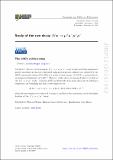Study of the rare decay J/ψ → μ+μ−μ+μ−
Author(s)
Aaij, R.; Abdelmotteleb, A. S. W.; Abellan Beteta, C.; Abudinén, F.; Ackernley, T.; Adefisoye, A. A.; Adeva, B.; Adinolfi, M.; Adlarson, P.; Agapopoulou, C.; Aidala, C. A.; Ajaltouni, Z.; Akar, S.; Akiba, K.; Albicocco, P.; Albrecht, J.; The LHCb collaboration; ... Show more Show less
Download13130_2024_Article_25071.pdf (3.000Mb)
Publisher with Creative Commons License
Publisher with Creative Commons License
Creative Commons Attribution
Terms of use
Metadata
Show full item recordAbstract
The rare electromagnetic J/ψ → μ+μ−μ+μ− decay is observed with a significance greatly exceeding the discovery threshold, using proton-proton collision data collected by the LHCb experiment during 2016–2018 at a center-of-mass energy of 13 TeV, corresponding to an integrated luminosity of 5.4 fb−1. The rate of this decay is measured relative to that of the J/ψ → μ+μ− mode. Using the QED model for the four-muon decay in the efficiency estimation, its branching fraction is determined to be B J / ψ → μ + μ − μ + μ − = 1.13 ± 0.10 ± 0.05 ± 0.01 × 10 − 6 , where the uncertainties are statistical, systematic and due to the uncertainty on the branching fraction of the J/ψ → μ+μ− decay.
Date issued
2024-12-10Department
Massachusetts Institute of Technology. Department of PhysicsJournal
Journal of High Energy Physics
Publisher
Springer Berlin Heidelberg
Citation
The LHCb collaboration., Aaij, R., Abdelmotteleb, A.S.W. et al. Study of the rare decay J/ψ → μ+μ−μ+μ−. J. High Energ. Phys. 2024, 62 (2024).
Version: Final published version